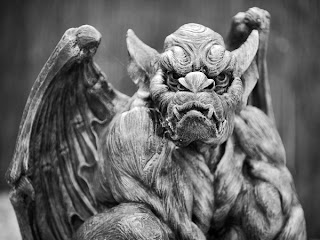Over time, metropolises like the City extend urban sprawl into areas which were formerly wilderness--wilderness haunted by monsters. Some monsters are pushed further out into the wilds, but others adapt to the new environments in which they find themselves. Then their are other creatures who have always been associated with man and his habitations in a variety of ways, from freeloader to predator. Here's a sampling of creatures one might encounter in the City and perhaps other urban areas:
Gargoyles: are Old World creatures who have been roosting in human cities since ancient times. Historically, some Earlderdish cities are reported to have formed pacts with gargoyle colonies for mutual protection. The creatures must have either stowed away or been purposely brought to the New World. Though admittedly ill-tempered and certainly capable of violence, they're generally not dangerous (except to small animals like pets) if given wide berth. Researchers in the City have tried to make contact with the sometimes temperamental creatures as its hoped that an understanding of the metabolic curse, pertrifactio progressiva, that causes gargoyles to age into stone statues might lead to an alchemical cure for petrification of various sorts.
Oozes/Slimes/Molds: These organisms can be found in underground areas like sewers and subway tunnels which they colonized from deeper strata of ruins, or where they were dumped by irresponsible alchemical concerns. These organisms have been known to spread up into basements, or even through the walls of decaying buildings. Such incursions often occasion a call to the Municipal Department of Animal and Pest Control.
Undead: Ghosts are common in cities, with other incorporeal undead somewhat less so. Spectral automobiles phantom trains, and the like are more common in cities than in rural areas. Freelance specialists do a brisk business in disposing of many sorts of hauntings. Zombies are utilized (illegally) in underground fighting competitions for the purposes of gambling, or as cheap labor. Skeletons are less frequently used because they attract too much attention, but some ostentatious necromancers employ them as (ahem)--muscle--for just that reason. Barrow-wights are sometimes found haunting potter’s fields, old catacombs, and occasionally upscale cemeteries, though the dark processes that initiate a wight infestation are not understood. Ghouls of the Strange New World are not actually undead, but have a taste for brains which make them dangerous, particularly if handled less than courteously. Vampires--blood junkies--tend to slide over their unlife from more respectable areas to slums where their victims are less likely to be missed.
Devils: The Hell Syndicate prefers to use human agents, keeping its infernal troops in reserve, but there are a few exceptions. Succubi and incubi are heavily involved in higher-priced prostitution rings. Hit-Fiends, mostly disguised (barely) as mundane muscle, back up particularly high-placed human gangsters, and are sent rub out particularly annoying adventurer-types.
10 hours ago





















